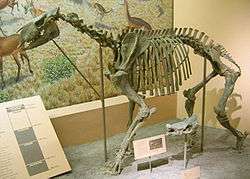Schizotheriinae
| Schizotheriinae Temporal range: 34–0.781 Ma Late Miocene to Early Pleistocene | |
|---|---|
 | |
| Moropus elatus at the National Museum of Natural History, Washington, DC | |
| Scientific classification | |
| Kingdom: | Animalia |
| Phylum: | Chordata |
| Class: | Mammalia |
| Order: | Perissodactyla |
| Suborder: | †Ancylopoda |
| Superfamily: | †Chalicotherioidea |
| Family: | †Chalicotheriidae |
| Subfamily: | †Schizotheriinae Holland and Peterson, 1914 |
| Genera | |
|
†Ancylotherium | |
Schizotheriines make up an extinct clade of the family Chalicotheriidae, a group of herbivorous, odd-toed ungulate (perissodactyl) mammals. Unlike the gorilla-like proportions of other chalicotheres, schizotheriines had smaller body proportions, closer to those of Moropus. Analysis of dental microwear implies most Miocene Schizotheriinae fed on leaves, bark, and twigs. Their claws were most likely used in a hook-like manner to pull down branches, suggesting they lived as bipedal browsers.[1] They are related to the modern horse, rhino, and tapir.[2]
References
- ↑ Coombs, Margery C. (13 Feb 2009). "The chalicothere Metaschizotherium bavaricum (Perissodactyla, Chalicotheriidae, Schizotheriinae) from the Miocene (MN5) Lagerstatte of Sandelzhausen (Germany): description, comparison, and paleoecological significance". Paläontologische Zeitschrift. Springer Berlin / Heidelberg. 83 (1): 85–129. doi:10.1007/s12542-009-0004-x. Retrieved 2009-12-29.
- ↑ Palmer, D., ed. (1999). The Marshall Illustrated Encyclopedia of Dinosaurs and Prehistoric Animals. London: Marshall Editions. p. 261. ISBN 1-84028-152-9.
See also
This article is issued from Wikipedia - version of the 6/30/2016. The text is available under the Creative Commons Attribution/Share Alike but additional terms may apply for the media files.